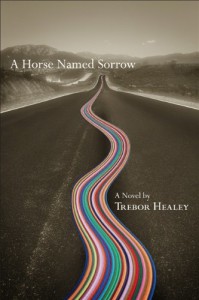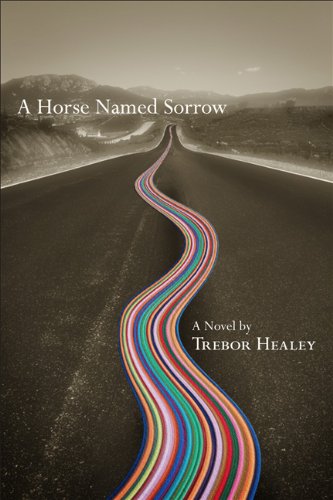 A Horse Named Sorrow
A Horse Named Sorrow
by Trebor Healey
Terrace Books. 275 pages, $26.95
TREBOR HEALEY’S LATEST NOVEL, A Horse Named Sorrow, is a painfully beautiful book. It’s also gloriously sexy and, along with Michelle Tea’s Valencia (2000), it’s among the finest depictions of queer life in 1990s San Francisco. Poetic, tragic, and often euphoric, it’s the kind of story that I found myself wanting to live inside of.
A picaresque novel in the truest sense, A Horse Named Sorrow is narrated by Seamus, an endearing romantic who meets the guy of his dreams on a San Francisco street at the tender age of 21. Jimmy, eight years older than Seamus, has just arrived on a cross-country bicycle trip from his hometown of Buffalo. During their erotically charged first day together, in which Seamus gives Jimmy a long bath to wash away the dirt of his journey, Jimmy reveals that he’s HIV-positive. It’s 1990, and he’s come to San Francisco to die. After losing track of each other and making a lucky reconnection, Seamus decides to take care of Jimmy during the last year of his life.
The book’s innovative chronology becomes apparent within the first couple of chapters, with Seamus alternating between flashbacks of his year with Jimmy and his present-day journey by bicycle to carry Jimmy’s ashes back to Buffalo. Seamus follows the exact same route that Jimmy took, using the latter’s well-worn road maps to guide him on the path (in reverse). He even rides Jimmy’s own bike, which is spangled with random threads of various colors and textures that Jimmy had picked up along the way and tied to the bike.
Given the storyline and subject matter, many of the scenarios that unfold along Seamus’ ride are both haunting and haunted. Because Seamus is not only riding Jimmy’s bike but also wearing Jimmy’s own Red Hot Chili Peppers T-shirt, we sense that some of the small-town characters whom Seamus encounters have a hazy memory of seeing Jimmy a little over a year ago. At one point, after spending the night at a church in rural Oregon, Seamus is followed by a dog for quite some distance, all the way to a river at the edge of town, as if she’s picked up on Jimmy’s scent or thinks that Seamus might be Jimmy’s ghost.
Elsewhere in Oregon, Seamus meets the second love of his life, who also seems like a vague ghost of Jimmy, while shopping at a health food store where the young man works. He’s Native American, and he’s also mute; Seamus nicknames him Eugene since that’s the name of the town where the store is located. Eugene doesn’t speak a single word throughout the novel’s latter half, though his emotional and sexual bond with Seamus is no less intense for being silent, to wit: “How he looked at me when he came, his eyes penetrating to the back of my skull where he drew his graffiti in bright colors right on my bones. He didn’t need to speak any words and I didn’t either.”
The midsection of the novel flattens out somewhat, just as Seamus’ slow bicycle journey across the country does, but neither the prose nor the ride are ever dull. In an all-encompassing, Whitmanesque fashion, Seamus is attuned to the details of the landscape at every moment, “dripping fir trees and drenched grasses … just endless forest, great hunks of bouldered stone … and the gray churning sky over forlorn, lonely meadows.” While he appreciates city life just as much as he appreciates nature, Seamus also muses over the fate of the planet as he pedals along his solitary road: “Urban gravity sucks everything down, sprouting acronyms and poison in its place.”
To reveal whether or not Seamus reaches his ultimate destination would be too much of a spoiler for those who are interested in reading the book. Suffice it to say that Trebor Healey’s hallucinatory and consummate final chapter does not disappoint. As he works his way up to his narrative finale, he draws cleverly and reverently on influences ranging from Jack Kerouac’s On the Road to John Rechy’s City of Night. What Healey has created by the end of Seamus’ tale is something new, a book that earns its place among those other indelible American novels.
________________________________________________________
Jason Roush, author of four books of poetry, teaches at Emerson College.






